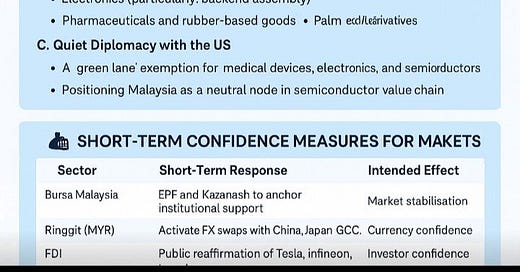As Prime Minister Anwar Ibrahim returns from his strategic outreach in Rio de Janeiro— where Malaysia sought deeper alignment with BRICS economic alternatives — he steps back into a volatile domestic and global climate. On the home front, mounting public dissatisfaction over fuel subsidy reforms, an emboldened opposition, and stagnating wage growth are fraying the threads of social cohesion. Globally, the spectre of US-imposed global tariffs (up to 24%) looms large over trade-dependent economies like Malaysia[^1].
To counteract these pressures, PM Anwar must pivot immediately into a two-front strategy: restoring domestic political stability while executing an urgent economic shielding plan.
1. Rebuilding Domestic Political Stability
A. Reinforce National Unity and Narrative Control
PMX must recast his Rio trip not merely as a diplomatic affair, but as a strategic hedge against Western protectionism. A nationwide address, perhaps under the banner of a “Majlis Kestabilan Ekonomi Negara” (National Council for Economic Stability), could frame Malaysia’s global diplomacy as defensive, not ideological[^2].
More importantly, he needs to co-opt key technocrats and even moderate opposition voices into this council, projecting a sense of inclusion over partisanship.
B. Defuse Perikatan Nasional’s Political Momentum
Fuel price rationalisation has proven politically explosive. PM Anwar must quickly:
Roll out targeted fuel subsidies using PADU-MyKad integration[^3];
Announce debt moratoriums for SMEs and selected B40 household debts[^4].
To outflank Perikatan Nasional’s populist rhetoric, PMX could also pilot local government elections in opposition-led states — allowing a controlled release of democratic pressure.
C. Restore Institutional Confidence
Corruption narratives are again eroding trust. A timeline for judicial reform and immediate action on high-profile corruption cases — accompanied by civil service reforms via AI-based digital governance — could boost confidence among the middle class and foreign investors alike[^5].
2. Economic Shielding Against US Tariffs
The Biden administration’s Inflation Reduction Act and CHIPS Act already pressure supply chains, while Trump’s return with a 24% blanket tariff threatens further economic contraction[^6].
A. De-risk Trade and FDI Exposure
Malaysia must:
Fast-track ASEAN-BRICS supply chain realignment (e.g., Malaysia-Brazil semiconductor R&D; read STORM 2024, https://monsoonsstorms.wordpress.com/2024/12/08/malaysia-brazil-semiconductor-partnership-opportunities-and-challenges/ ).
Activate currency swap agreements with China, UAE, and India to buffer against dollar dependency[^7].
Existing Special Economic Zones (SEZs) like the Johor-Singapore corridor can be turned into strategic rerouting zones, allowing Malaysian exports to transit via third-party jurisdictions, avoiding direct tariff hits[^8].
B. Targeted Support for At-Risk Industries
Tariffs will hit key Malaysian export sectors:
Electronics (especially backend assembly);
Pharmaceuticals and rubber-based goods;
Palm oil derivatives.
Anwar’s cabinet must introduce:
Export credit guarantees;
Temporary tax relief for tariff-exposed firms[^9].
C. Quiet Diplomacy with the US
Malaysia should propose:
A “green lane” exemption for medical devices, electronics, and semiconductors;
A positioning narrative that frames Malaysia as a neutral node in the semiconductor value chain, not a geopolitical threat[^10].
Business diplomacy must be fronted by the US-Malaysia Business Council and regional trade chambers.
Conclusion: Act Now, or Be Acted Upon
PM Awar Ibrahim faces a compressed political calendar and a tightening global economy. Failure to act now —both in stabilising the political sphere and shielding the economy — could trigger capital flight, credit downgrades, and a full-scale populist resurgence.
The task ahead is clear: fortify domestic legitimacy while insulating Malaysia from geopolitical shocks. To do so requires urgency, clarity, and the full apparatus of a government acting in unison.
Footnotes & References
[^1]: Reuters (2024). US mulls universal 24% tariff under Trump II strategy; Theedgemalaysia.com (9/07/2025). Economists expect bigger cuts to Malaysia’s growth aftet Trump slaps 25% tariff on goods
[^2]: BRICS Policy Centre (2024). Malaysia’s outreach to BRICS as a hedge against US decoupling.
[^3]: Ministry of Finance Malaysia (2025). PADU integration for targeted subsidies: System roadmap.
[^4]: BNM Circular (2023). Household credit vulnerability report.
[^5]: IDEAS Malaysia (2024). Restoring public trust: Judiciary and civil service reforms.
[^6]: CSIS (2023). CHIPS Act and Southeast Asia supply chain implications.
[^7]: Bank Negara Malaysia (2024). FX swap agreements as strategic buffers.
[^8]: World Bank Malaysia Office (2025). SEZs as insulation tools in trade realignment; see STORM 2025. https://monsoonsstorms.wordpress.com/2025/01/11/sez-shall-malaysia-seize-the-economic-advantages-in-the-arenas-of-competition/
[^9]: MITI Malaysia (2025). Industrial contingency tools under global tariff pressures.
[^10]: US-Malaysia Business Council (2025). Trade neutrality in semiconductors and advanced electronics.



